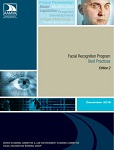Customer privacy and the protection of personal information is paramount and should be consistent with the laws of the jurisdiction. Although biometric matching itself raises privacy concerns for some, the use of the technology actually helps protect people’s privacy and personal identities. Moreover, it is a basic tenet that potential matches from facial recognition should generate human examination and no other action, such as an arrest or corrective action, should be taken solely on the basis of a FR result.
AAMVA originally published a Facial Recognition Best Practices Guide in 2015.The Law Enforcement Standing Committee recommended, and the AAMVA Board approved, a 2019 Facial Recognition Working Group (hereinafter referred to as the Working Group) to update the Guide to ensure the content and recommended best practices were based on the most up-to-date information.
 Download
Download
AAMVA originally published a Facial Recognition Best Practices Guide in 2015.The Law Enforcement Standing Committee recommended, and the AAMVA Board approved, a 2019 Facial Recognition Working Group (hereinafter referred to as the Working Group) to update the Guide to ensure the content and recommended best practices were based on the most up-to-date information.
